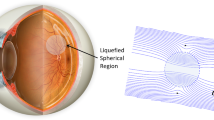Abstract
The cornea of the human eye is cooled by the surrounding air and by evaporation of the tear film. The temperature difference between the cornea and the iris (at core body temperature) causes circulation of the aqueous humor in the anterior chamber of the eye. Others have suggested that the circulation pattern governs the shape of the Krukenberg spindle, a distinctive vertical band of pigment on the posterior cornea surface in some pathologies. We modeled aqueous humor flow the human eye, treating the humor as a Boussinesq fluid and setting the corneal temperature based on infrared surface temperature measurements. The model predicts convection currents in the anterior chamber with velocities comparable to those resulting from forced flow through the gap between the iris and lens. When paths of pigment particles are calculated based on the predicted flow field, the particles circulate throughout the anterior chamber but tend to be near the vertical centerline of the eye for a greatest period of time. Further, the particles are usually in close proximity to the cornea only when they are near the vertical centerline. We conclude that the convective flow pattern of aqueous humor is consistent with a vertical pigment spindle. © 2002 Biomedical Engineering Society.
PAC2002: 4266Ew, 8710+e, 8719Pp
Similar content being viewed by others
REFERENCES
Al–Badwaihy, K. A., and A. B. A. Youssef. Biological thermal effect of microwave radiation on human eyes. In: Biological Effects of Electromagnetic Waves, edited by Johnson, C. C., and M. L. Shore. Washington, DC: DHEW Publication, 1976, pp. 61–78.
Bergenske, P. D. Krukenberg's spindle and contact lens–induced edema. Am. J. Optom. Physiol. Opt. 57:932–935, 1980.
Beswick, J. A., and C. McCulloch. Effect of hyaluronidase on the viscosity of the aqueous humour. Br. J. Ophthamol. 40:545–548, 1956.
Efron, N., G. Young, and N. A. Brennan. Ocular surface temperature. Curr. Eye Res. 8:901–905, 1989.
ElSherbiny, S. M., G. D. Raithby, and K. G. T. Hollands. Heat transfer by natural convection across vertical and inclined air layers. J. Heat Transfer 104:96–102, 1982.
Emery, A. F., P. Kramar, A. W. Guy, and J. C. Lin. Microwave induced temperature rises in rabbit eyes in cataract research. J. Heat Transfer 97:123–128, 1975.
Fontana, S. T., and R. F. Brubaker. Volume and depth of the anterior chamber of the normal aging human eye. Arch. Ophthalmol. (Chicago) 98:1803–1808, 1980.
Hart, W. M. Adler's Physiology of the Eye. St. Louis: Mosby Year Book, 1992, p. 888.
Heys, J. J., V. H. Barocas, and M. J. Taravella. Modeling passive mechanical interaction between aqueous humor and iris. J. Biomech. Eng. 123:540–547, 2001.
Incropera, F. P., and D. P. DeWitt. Fundamentals of Heat and Mass Transfer, 2nd ed. New York: Wiley, 1985, p. 802.
Kobayashi, A. S., S. L. Y. Woo, C. Lawrence, and W. A. Schlegel. Analysis of the corneoscleral shell by the method of direct stiffness. J. Biomech. 4:323–330, 1971.
Kocak, I., S. Orgul, and J. Flammer. Variability in the measurement of corneal temperature using a noncontact infrared thermometer. Ophthalmologica 213:345–349, 1999.
Kuchle, M., C. Y. Mardin, N. X. Nguyen, P. Martus, and G. O. H. Naumann. Quantification of aqueous melanin granules in primary pigment dispersion syndrome. Am. J. Ophthalmol. 126:425–431, 1998.
Lagendijk, J. J. W. A mathematical model to calculate temperature distributions in human and rabbit eyes during hyperthermic treatment. Phys. Med. Biol. 27:1301–1311, 1982.
Mapstone, R. Measurement of corneal temperature. Exp. Eye Res. 7:237–243, 1968.
Morgan, P. B., A. B. Tullo, and N. Efron. Infrared thermography of the tear film in dry eye. Eye 9:615–618, 1995.
Mori, A., Y. Oguchi, E. Goto, K. Nakamori, T. Ohtsuki, F. Egami, J. Shimazaki, and K. Tsubota. Efficacy and safety of infrared warming of the eyelids. Cornea 18:188–193, 1999.
Mori, A., Y. Oguchi, Y. Okusawa, M. Ono, H. Fujishima, and K. Tsubota. Use of high–speed, high–resolution thermography to evaluate the tear film layer. Am. J. Ophthalmol. 124:729–735, 1997.
Moses, R. A. Intraocular pressure. In: Adler's Physiology of the Eye, 6th ed., edited by Moses, R. A. St. Louis: C. V. Mosby Company, 1975, pp. 179–191.
Moses, R. A. The iris and the pupil. In: Adler's Physiology of the Eye, 6th ed., edited by Moses, R. A. St. Louis: The C. V. Mosby Company, 1975, pp. 320–323.
Natural Convection in a Square Cavity. In: FIDAP 7.0 Examples Manual. Lebanon, NH: Fluent Inc., 1993, Chap. 7, pp. 7–1–7–22.
Okuno, T. Thermal effect of infra–red radiation on the eye: a study based on a model. Ann. Occup. Hyg. 35:1–12, 1991.
Patil, P. N. Enhanced sensitivity of the iris sphincter to the muscarinic agonist carbachol at lower temperature. J. Ocular Pharmacol. Therap. 15:65–71, 1999.
Robinson, C. H., W. Nopanitaya, and S. D. McPherson. Pigmentary glaucoma: An ultrastructural study. Ann. Ophthalmol. 13:49–51, 1981.
Rodrigues, M. M., G. L. Spaeth, S. Weinreb, and E. Sivalingam. Spectrum of trabecular pigmentation in open–angle glaucoma: A clinicopathologic study. Tr. Am. Acad. Ophthalmol. Oto–laryngol. 81:258–276, 1976.
Rodrigues, M. M., G. O. Waring, J. Hackett, and P. Donohoo. Cornea. In: Ocular Anatomy, Embryology, and Teratology, edited by Jakobiec, F. A. Philadelphia: Harper and Row, 1982, pp. 153–166.
Scott, J. A. A finite element model of heat transport in the human eye. Phys. Med. Biol. 33:227–241, 1988.
Author information
Authors and Affiliations
Rights and permissions
About this article
Cite this article
Heys, J.J., Barocas, V.H. A Boussinesq Model of Natural Convection in the Human Eye and the Formation of Krukenberg's Spindle. Annals of Biomedical Engineering 30, 392–401 (2002). https://doi.org/10.1114/1.1477447
Issue Date:
DOI: https://doi.org/10.1114/1.1477447




